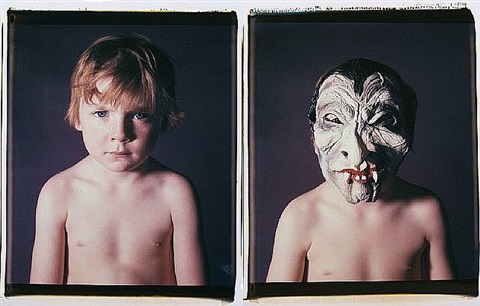b. 1961
Los Angeles-based Catherine Opie, one of the most important photographers of her generation, produces serial images of landscapes, cityscapes, portraits, and groups of people, portraying modern life in conceptual and documentary styles. While Los Angeles has figured prominently in her photographs of its freeway system, landscapes, national parks, and subcultures, she has also been photographing overlooked aspects of contemporary American life, including seminal portraits of the LGBT community
Opie received a B.F.A. from the San Francisco Art institute in 1985 and an M.F.A. from Cal Arts in 1988. Her thesis project “Master Plan” examined the planned communities of Valencia, California. Since 2001 she has been a professor of photography at UCLA, and in 2019 she was the university’s inaugural endowed chair in the art department, which was an undergraduate and graduate teaching position. Recently UCLA has named Opie the departmental chair, which is the lead administrative position to work with faculty to develop curriculum for the art department.
Opie’s portraits explore relationships of individuals to their social communities. Her early series “Being and Having” 1991 and “Portraits” 1993-1997 depicted her friends in Los Angeles’s lesbian, gay and leather community, mixing traditional portrait photography with less traditional images of cutting and bondage. In one of her best-known early works, “Self-Portrait/Cutting” 1993, her bare back is carved with a still-bleeding drawing of a home and two female stick figures. In her 1999 “Domestic” series, she photographed lesbian couples in their homes.
Opie’s “Freeways” 1994 began her images of L.A.’s highways near her home where she excluded people and automobiles from her compositions. Three years later she continued this exploration of contemporary cityscapes with her series “Mini-malls.” Traveling outside the Los Angeles area to find new landscapes and cityscapes, she photographed the New York financial district, once again emptied of people in the series “Wall Street” and scenes of Minnesota in “Icehouses” and “Skyways” all done in 2001. In 2004, she extended her study of unpeopled urban sites in her “American Cities” with black and white photographs of Chicago.
For the series “In and Around the Home” 2004-2005 Opie turned to her home and community to show political and social conflicts surrounding the presidential election at that time. In 2011, she spent six months photographing images of the home of Elizabeth Taylor, an actress, philanthropist, and advocate, who rallied support for victims of AIDS. The pictures were taken before and after Taylor’s hospitalization and death in March 2011. In two series “Closets and Jewels” and “700 Nimes Road” Opie created an indirect portrait of Taylor from her personal space, mementos, jewels, and makeup. These photographs were shown at MOCA Pacific Design Center in 2016.
Starting in 2013, she evoked seventeenth-century portraiture, presenting subjects in front of black backgrounds, which removed her people from any sense of time or place. Thirteen of her Old Master-influenced portraits of contemporary people were shown in 2017 in a solo show at Thomas Dane Gallery in London. Her “Portraits and Landscapes” were formal, controlled portraits where she used the Northern Renaissance artist Hans Holbein as her inspiration.
In 2016, Opie made her first film “The Modernist.” It was a 22-minute piece which followed the exploits of an artist, who has turned into an arsonist. He has set his sights on famous L.A. midcentury homes, those modernist houses that were supposed to be part of the American dream. “The Modernist” is a silent film except for the one moment when the arsonist lights a match, and the sound of it makes a viewer jump. He has chosen to set fire to a failed dream.
Opie’s exhibition, “Rhetorical Landscapes,” was a series of stop-motion animations that addressed the issues of climate change, gun control, immigration, and the environment. The images became part of an animated collage with digitized cutouts of ocean scenes and architectural landmarks serving as a backdrop.
Opie views the current misogyny and hatred in America as alarming. Using misogyny in the art world as an example, she states, “Being a professor, I track my students, and I have to say that the majority of my male students seem to do very well after graduating, while for my female students it’s much harder. It’s also visible in the relationship between the quality of the work and money.”
Opie has received many awards, including one from the Smithsonian and a 2009 Presidential Award for Lifetime Achievement. Her work has appeared twice in the Whitney Biennial, 1995 and 2004; the Melbourne International Biennial, 1999; and SITE Santa Fe Biennial, 2006. She has participated in group exhibitions at Centre Pompidou, Guggenheim, Guggenheim Bibao, Brooklyn Museum, Museum of Modern Art, Getty Center, National Portrait Gallery, Whitney Museum of American Art, Los Angeles’s Museum of Contemporary Art, and Museo Nacional Centro de Arte Reina Sofia.
She has had numerous solo shows at Los Angeles’s Museum of Contemporary Art, Saint Louis Art Museum, Walker Art Center, MOCA Chicago, Guggenheim Museum, Los Angeles County Museum of Art, Portland Art Museum, Institute of Contemporary Art, and Wexner Center for the Arts among others.
Her work is in the permanent collections of Museum of Contemporary Art, Los Angeles County Museum of Art, New York’s Museum of Modern Art, Guggenheim Museum, Whitney Museum of American Art, Tate Modern, and others.
More here.
